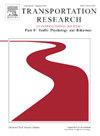Examining Drivers’ red- and Yellow-Light running behaviors: An extended theory of planned behavior approach
IF 3.5
2区 工程技术
Q1 PSYCHOLOGY, APPLIED
Transportation Research Part F-Traffic Psychology and Behaviour
Pub Date : 2025-05-28
DOI:10.1016/j.trf.2025.05.026
引用次数: 0
Abstract
The prevalence of red-light running (RLR) among drivers in Iran is notably high. To mitigate RLR violations and alleviate the anxiety of stopping behind traffic lights, traffic authorities implemented various types of systems to display the remaining traffic light time, such as hourglass, tally, and countdown timers. This study applies and extends the theory of planned behavior (TPB) to describe the drivers’ yellow light running (YLR) and RLR intentions at intersections equipped with various timers. Furthermore, this research identifies whether extended TPB framework explains drivers’ RLR/YLR intentions with and without prior violations. A total of 680 questionnaires were collected, including 280 for RLR and 400 YLR. While drivers did not deny the benefits of RLR/YLR and the social pressure to engage in these behaviors, their intentions were highly influenced by the facilitating conditions, descriptive norms, and conformity tendency. These findings suggest that drivers crossed the intersection because they observed others doing so, wanted to emulate such behavior, and found external conditions favorable for crossing. Drivers perceived a lack of personal control over the negative consequences and legal responsibilities associated with passing intentions. Multi-group analysis revealed significant differences between almost all the psychological variables of red- and yellow-light runners. However, no meaningful differences were observed based on the type of timer faced by drivers or the frequency of prior violations. These findings can guide the development of strategies to encourage compliance with red/yellow signals through targeted (re)training courses or safety awareness campaigns.
司机闯红灯和黄灯行为的研究:计划行为方法的扩展理论
在伊朗,司机闯红灯(RLR)的发生率非常高。为了减少违反RLR的行为,减轻在红绿灯后停车的焦虑,交通当局实施了各种类型的系统来显示剩余的红绿灯时间,如沙漏、计数和倒计时计时器。本研究运用并扩展了计划行为理论(TPB)来描述驾驶员在设置不同计时器的十字路口的黄灯和不黄灯意图。此外,本研究确定了扩展的TPB框架是否解释了驾驶员在有或没有违规行为的情况下的RLR/YLR意图。共回收问卷680份,其中RLR问卷280份,YLR问卷400份。尽管司机不否认参与这些行为的利益和社会压力,但他们的意图受到促进条件、描述性规范和从众倾向的高度影响。这些发现表明,司机过十字路口是因为他们看到别人这样做,想要模仿这样的行为,并发现有利于过十字路口的外部条件。司机们认为,对与超车意图相关的负面后果和法律责任缺乏个人控制。多组分析显示,闯红灯和闯黄灯跑步者的几乎所有心理变量都存在显著差异。然而,根据驾驶员面临的计时器类型或先前违规频率,没有观察到有意义的差异。这些发现可以指导制定战略,通过有针对性的(再)培训课程或安全意识运动来鼓励遵守红/黄信号。
本文章由计算机程序翻译,如有差异,请以英文原文为准。
求助全文
约1分钟内获得全文
求助全文
来源期刊
CiteScore
7.60
自引率
14.60%
发文量
239
审稿时长
71 days
期刊介绍:
Transportation Research Part F: Traffic Psychology and Behaviour focuses on the behavioural and psychological aspects of traffic and transport. The aim of the journal is to enhance theory development, improve the quality of empirical studies and to stimulate the application of research findings in practice. TRF provides a focus and a means of communication for the considerable amount of research activities that are now being carried out in this field. The journal provides a forum for transportation researchers, psychologists, ergonomists, engineers and policy-makers with an interest in traffic and transport psychology.

 求助内容:
求助内容: 应助结果提醒方式:
应助结果提醒方式:


